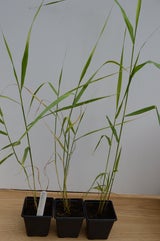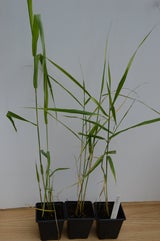- Food and Nectar Plants
- >
- Caterpillar Food Plants
- >
- Common Reed (Phragmites australis), 3 plants in 7 cm or 9 cm pots
Common Reed (Phragmites australis), 3 plants in 7 cm or 9 cm pots
Common Reed (Phragmites australis) is an imposing grass commonly displaying on the banks of ponds and streams, with a size (up to several metres) and flower head to rival that of any of the garden ornamentals, and it's native, which means it supports native wildlife. Its a favourite reed for thatching and for water purification so gives plenty to talk about if grown in a damp herbaceous border.
I took the photograph of the reed growing on the banks of a pool at the North Haugh, St Andrews, and the second on the banks of a stream running alongside our wildflower garden at Cupar, Fife.
Value to Wildlife
The flower spikes are at first dark purple, changing to brown as the flowers mature. Large stands are an important wildlife habitat for birds and insects. Its hollow stems can be collected in autumn and used, like the hollow stems of Hogweed, for making 'nesting sites' for solitary bees.
Your Purchase
You are buying THREE well-rooted plants in 7 cm square pots, which we have nurtured from native seed in peat-free compost. All of our plants are grown from seed either purchased from reputable suppliers of wild flower seed in England and Scotland, or increasingly, from flowers growing in our own wildflower gardens in Fife, Scotland..
Purchase at any time of year. Like other native grasses, its leaves will die back in winter and at this time the plants may look a mess, but the strong roots are winter hardy and planted out in damp soil near a stream or pond will give rise to a fresh burst of green leaves in spring.
As it grows very tall we may need to cut the stems down to size - as we would with those in the photograph - so that they fit into the packaging, but as with most wildflowers, this does no harm and simply stimulates growth.
Plant Passport Registration Number GB-S 03473.



